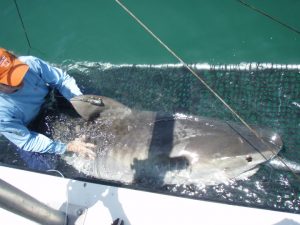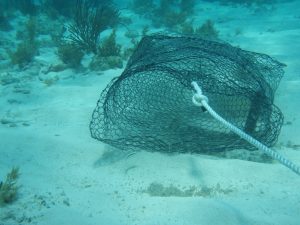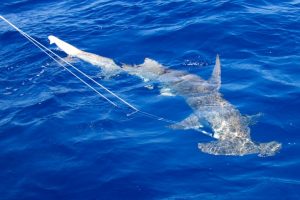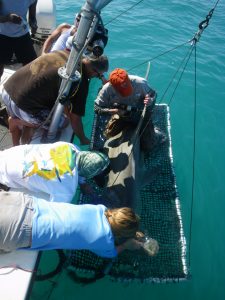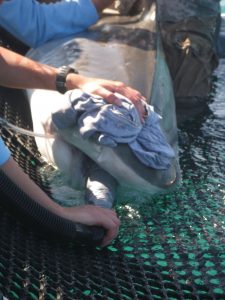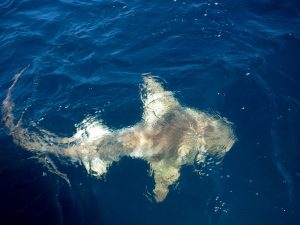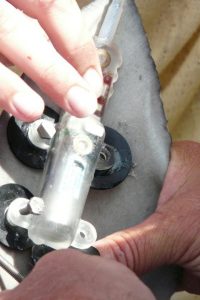Reunited – Shark Trips June 9-11
Reunited
Our most recent research trip took the shark team to Bonita Springs, FL, a new field location for us that is showing major promise for its abundance of large predators. This was the second time the RJ Dunlap Shark team traveled to the gulf for shark research, a partnership that involves researchers from Florida Gulf Coast University and the Vester Marine Station. Our previous trip to this site yielded some very exciting catches, including several tiger sharks. As we passed through the Everglades on our drive across south Florida, we hoped to get similar results as our previous trip. Little did we know that what would transpire two days later would shock us and really impact us as shark researchers.
The trip started with the usual pre-departure inventory. Enough bait? Check. Fishing gear intact and accounted for? Satellite tags ready to be attached to big sharks? Double check. We were off, ready to go sharking. As I sat on the bow of the boat enjoying the windy-salvation from the blistering sun, I couldn’t help but think of the oil catastrophe lurking just to the west. You can watch all the news specials and read as many articles about the spill as you want, but you don’t truly feel the implications of it all until you see firsthand what is at stake. As we navigated our way through the mangrove canals of Bonita Springs, we were constantly reminded of how impressive healthy marine biodiversity really is. Making our way out to sea, we were greeted by manatees, ospreys, cranes, and dolphins, all of which painted a perfect picture of a properly functioning marine ecosystem and its many connecting food webs. The target of our research—the shark– sits precariously on top of all of those food webs.
On day one we were accompanied by some local press and photographers interested in covering our satellite tagging project. As usual, 10 drumlines went in the water and were picked up an hour and a half later. No sharks. Could the slack tide and/or high barometric pressure contributed to the lack of sharks on our first set? Staying positive, we re-baited and deployed another set of drumlines. While hauling up one of our first drumlines, a white body slowly appeared from the murky depths. The round and broad head quickly gave it away-it was a tiger shark. We brought the 9.5 foot female (given the name Virginia) into our sling and worked her up quickly, fitting her with her own SPOT tag and releasing her back to the productive waters of Florida’s gulf coast.
There is something truly mystifying about looking into the eyes of a tiger shark. It is almost unexplainable, but they seem to have their own personality and demeanor about them. Their seemingly calm “attitude” is quite the paradox to the aggressive, license-plate devouring reputation that tiger sharks have. That afternoon also yielded a blacktip, a blacknose and several nurse sharks—all of which were tagged, measured and released in healthy condition. This is an exciting time for the RJ Dunlap program, as we are gathering data for multiple projects on each trip—including ongoing studies on tagging, predator abundances and ecotoxicology, as well as some new studies on behavior and physiology of sharks.
The second day was also quite productive—filed with successful sampling on blacktips and nurse sharks. The second day’s highlights were also tiger-related. We satellite tagged another tiger shark, an 8 foot female (named Domski). The sling on the research boat is a very helpful research tool, as it securely and safely holds large sharks such as tigers, bulls, and hammerheads. This practice maximizes efficiency and promotes safety for us and the sharks. As always, a water pump was used to keep water flowing over each of our shark gills while we took our measurements.

Pump in the Shark’s mouth and Research Assistant Austin Gallagher conducting behavioral tests to examien shark health (Click to Enlarge)
The biggest surprise that day came when we recaptured one of our previously tagged tiger sharks! Recapturing ANY tagged shark is rare, but recapturing one of the tiger sharks we actually satellite tagged ourselves was such an amazing sight. The shark, which was later identified to be Kelli, actually swam right up to the boat by herself and investigated us. She also had a large cobia trailing her every move—an observation that suggests that she had been foraging and capturing prey naturally (most fish like remoras, pilot fish, etc that trail or hitch rides with sharks are there to pick up scraps). We brought her up to the side of the boat and got some excellent photos of her while inspecting the tag and then re-releasing her. This moment was really important for our tagging program, since it showed that our sharks are released in healthy condition—it was a perfect reunion.
Our final day of sharking produced several nurse sharks, a species that always provides what seems like a wrestling match in order to get measurements. Lastly, we caught a 12 foot great hammerhead. We placed a satellite tag on the female leviathan and gave her the name “Jacques Cousteau,” in honor of the 100th birthday of the famous ocean explorer. After releasing her, we watched in awe and appreciation as her large sickle-shaped dorsal fin and new satellite tag disappeared together beneath the waves, unaware that she may give way to new discoveries of shark behavior and conservation.
Will we return to Bonita springs to continue our research on sharks? You bet. Will she sharks be back or will they move off into other areas? Only time will tell, and we can’t wait to find out. Stay tuned and track our sharks as the data comes in!
Austin Gallagher (Research Assistant)
Check out several write ups on our recent shark collaboration with FGCU in the Island Press News Paper:



